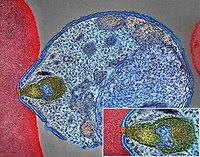
Photo from wikipedia
Objectives To systematically review the literature on the unit cost and cost-effectiveness of malaria control. Methods Ten databases and gray literature sources were searched to identify evidence relevant to the… Click to show full abstract
Objectives To systematically review the literature on the unit cost and cost-effectiveness of malaria control. Methods Ten databases and gray literature sources were searched to identify evidence relevant to the period 2005 to 2018. Studies with primary financial or economic cost data from malaria endemic countries that took a provider, provider and household, or societal perspective were included. Results We identified 103 costing studies. The majority of studies focused on individual rather than combined interventions, notably insecticide-treated bed nets and treatment, and commonly took a provider perspective. A third of all studies took place in 3 countries. The median provider economic cost of protecting 1 person per year ranged from $1.18 to $5.70 with vector control and from $0.53 to $5.97 with chemoprevention. The median provider economic cost per case diagnosed with rapid diagnostic tests was $6.06 and per case treated $9.31 or $89.93 depending on clinical severity. Other interventions did not share enough similarities to be summarized. Cost drivers were rarely reported. Cost-effectiveness of malaria control was reiterated, but care in methodological and reporting standards is required to enhance data transferability. Conclusions Important information that can support resource allocation was reviewed. Given the variability in methods and reporting, global efforts to follow existing standards are required for the evidence to be most useful outside their study context, supplemented by guidance on options for transferring existing data across settings.
Journal Title: Value in Health
Year Published: 2021
Link to full text (if available)
Share on Social Media: Sign Up to like & get
recommendations!